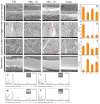Physiological and Morphological Responses of Blackberry Seedlings to Different Nitrogen Forms
- PMID: 37050106
- PMCID: PMC10097381
- DOI: 10.3390/plants12071480
Physiological and Morphological Responses of Blackberry Seedlings to Different Nitrogen Forms
Abstract
Blackberries are an emerging third-generation fruit that are popular in Europe, and specific nitrogen (N) supply is an important factor affecting their growth and development. To study the optimal N fertilizer for blackberry seedlings, no N (CK), nitrate (NO3-)-N, ammonium (NH4+)-N and urea were applied to one-year-old 'Ningzhi 4' blackberry plants at a key growth period (from May to August) to explore the effects of different N forms on the physiological characteristics. Correlation and principal component analysis were used to determine the relationships between various indexes. Ammonium (NH4+) or urea-fed plants had a better growth state, showed a greater plant height, biomass, SPAD values and enhanced antioxidant enzyme activities and photosynthesis. In addition, NH4+ was beneficial to the accumulation of sugars and amino acids in leaves and roots, and promoted the transport of auxin and cytokinin to leaves. NO3- significantly inhibited root growth and increased the contents of active oxygen, malondialdehyde and antioxidants in roots. Correlation and principal component analysis showed that growth and dry matter accumulation were closely related to the antioxidant system, photosynthetic characteristics, amino acids and hormone content. Our study provides a new idea for N regulation mechanism of blackberry and proposes a scientific fertilization strategy.
Keywords: ammonium; blackberry; nitrate; nitrogen; physiological parameters; plant growth.
Conflict of interest statement
The authors declare no conflict of interest.
Figures







Similar articles
-
Effects of the nitrate and ammonium ratio on plant characteristics and Erythropalum scandens Bl. substrates.PLoS One. 2023 Aug 4;18(8):e0289659. doi: 10.1371/journal.pone.0289659. eCollection 2023. PLoS One. 2023. PMID: 37540657 Free PMC article.
-
Growth and nitrogen metabolism in Sophora japonica (L.) as affected by salinity under different nitrogen forms.Plant Sci. 2022 Sep;322:111347. doi: 10.1016/j.plantsci.2022.111347. Epub 2022 Jun 11. Plant Sci. 2022. PMID: 35700842
-
Integrative physiological, metabolomic and transcriptomic analysis reveals nitrogen preference and carbon and nitrogen metabolism in blackberry plants.J Plant Physiol. 2023 Jan;280:153888. doi: 10.1016/j.jplph.2022.153888. Epub 2022 Dec 23. J Plant Physiol. 2023. PMID: 36577314
-
Ammonium uptake and metabolism alleviate PEG-induced water stress in rice seedlings.Plant Physiol Biochem. 2018 Nov;132:128-137. doi: 10.1016/j.plaphy.2018.08.041. Epub 2018 Aug 31. Plant Physiol Biochem. 2018. PMID: 30189416
-
Nitrogen form differently modulates growth, metabolite profile, and antioxidant and nitrogen metabolism activities in roots of Spartina alterniflora in response to increasing salinity.Plant Physiol Biochem. 2022 Mar 1;174:35-42. doi: 10.1016/j.plaphy.2022.01.031. Epub 2022 Jan 31. Plant Physiol Biochem. 2022. PMID: 35121483
Cited by
-
Nitrogen Use Efficiency in Oil Palm Seedlings: Unraveling the Untapped Potential of Elevated External Ammonium Supply.Plants (Basel). 2023 Jul 30;12(15):2819. doi: 10.3390/plants12152819. Plants (Basel). 2023. PMID: 37570973 Free PMC article.
-
Effects of Drought Stress on Leaf Functional Traits and Biomass Characteristics of Atriplex canescens.Plants (Basel). 2024 Jul 22;13(14):2006. doi: 10.3390/plants13142006. Plants (Basel). 2024. PMID: 39065532 Free PMC article.
-
Growth and Physiological Traits of Blueberry Seedlings in Response to Different Nitrogen Forms.Plants (Basel). 2025 May 12;14(10):1444. doi: 10.3390/plants14101444. Plants (Basel). 2025. PMID: 40431009 Free PMC article.
-
Physiological and Agronomical Response of Coffee to Different Nitrogen Forms with and without Water Stress.Plants (Basel). 2024 May 16;13(10):1387. doi: 10.3390/plants13101387. Plants (Basel). 2024. PMID: 38794457 Free PMC article.
-
Effects of Different Forms and Proportions of Nitrogen on the Growth, Photosynthetic Characteristics, and Carbon and Nitrogen Metabolism in Tomato.Plants (Basel). 2023 Dec 15;12(24):4175. doi: 10.3390/plants12244175. Plants (Basel). 2023. PMID: 38140502 Free PMC article.
References
-
- Yang H., Zhang C., Wu W., Li W., Wei Y., Dong S. Physiological responses of blackberry cultivar ‘Ningzhi 1’ to drought stress. Russ. J. Plant Physiol. 2015;62:472–479. doi: 10.1134/S1021443715040184. - DOI
-
- Strik B.C., Clark J.R., Finn C.E., Bañados M.P. Worldwide blackberry production. HortTechnology. 2007;17:205–213. doi: 10.21273/HORTTECH.17.2.205. - DOI
Grants and funding
- BE2020344/"Research on Extraction and Utilization Technology of 'Three Berries' Functional Components in Nanjing National Agricultural High-Tech Industry Demonstration Zone
- JATS [2021]511 and JATS [2022]510/the earmarked fund for Jiangsu Agricultural Industry Technology System
- JBGS [2021]021/JBGS Project of Seed Industry Revitalization in Jiangsu Province .
LinkOut - more resources
Full Text Sources
Research Materials

